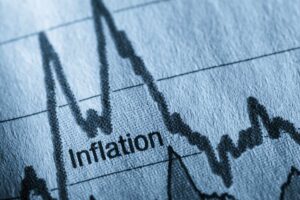Inflation is often seen as a silent thief that gradually erodes the value of your money over time. While it is a natural part of any economy, understanding its effects on your savings is crucial for maintaining financial health. Inflation can have significant implications for your purchasing power, long-term savings goals, and retirement plans. In this article, we explore how inflation impacts your savings and provide strategies to protect your wealth from its effects.
Table of Contents
What is Inflation?
Inflation refers to the rate at which the general level of prices for goods and services rises, causing the purchasing power of money to decline. When inflation is present, each unit of currency buys fewer goods and services, effectively reducing the value of your money. It is commonly measured by the Consumer Price Index (CPI), which tracks the price changes of a basket of goods over time.
While some level of inflation is normal in a growing economy, high inflation can significantly impact your financial well-being, especially if your income does not increase at the same rate as the rising prices.
How Inflation Affects Your Savings
The impact of inflation on your savings can be profound, especially over long periods. Here’s how it affects different aspects of your financial life:
1. Eroding Purchasing Power
As prices for everyday goods and services increase, the purchasing power of your savings declines. For example, if you have $10,000 saved in a bank account with no interest, and inflation is at 3% per year, the real value of your money after one year would be approximately $9,700. This means that you can buy less with the same amount of money as time goes on.
2. Impact on Cash Savings
Cash savings accounts, such as traditional savings accounts and money market accounts, often provide minimal interest rates. When these rates are lower than the inflation rate, the real value of your cash savings decreases. Although your account balance may remain the same, the actual purchasing power of the money declines as inflation rises. This makes cash savings a poor choice for long-term financial goals.
3. Affecting Retirement Planning
Inflation can significantly impact retirement planning, especially if you are relying on fixed-income sources, such as pensions or annuities. If your retirement income does not increase with inflation, your standard of living may decline over time. This is particularly concerning for retirees who have decades to live off their savings. For example, if you expect to retire in 20 years, even a modest inflation rate of 2% per year would reduce the purchasing power of your money by nearly 50%.
4. Impact on Investments
While some investments, such as stocks, have the potential to outpace inflation, others may not perform as well. For instance:
- Fixed-income investments like bonds may struggle during periods of high inflation, as the fixed interest payments may not keep up with the rising cost of living.
- Real estate investments, on the other hand, can act as a hedge against inflation since property values and rental income often rise with inflation.
Why You Should Care About Inflation
Inflation affects everyone, regardless of income or lifestyle. If your money isn’t growing at the same rate as inflation, you are effectively losing wealth. Understanding inflation’s effects on your savings and investments is the first step to mitigating its impact.
Strategies to Protect Your Savings from Inflation
To shield your savings from the negative effects of inflation, consider the following strategies:
1. Invest in Assets That Outpace Inflation
Investing in assets that have the potential to grow faster than inflation can help preserve your purchasing power. Here are some options:
- Stocks: Over the long term, stocks have historically provided returns that exceed inflation. While they come with risks, a well-diversified stock portfolio can help you achieve growth that outpaces inflation.
- Real Estate: Property values often rise with inflation, and rental income can provide a steady cash flow that keeps pace with the cost of living.
- Commodities: Investments in commodities such as gold, oil, and agricultural products can act as a hedge against inflation. When inflation rises, the prices of these commodities often increase as well.
2. Use Inflation-Indexed Bonds
Inflation-indexed bonds, such as Treasury Inflation-Protected Securities (TIPS), are designed to protect investors from inflation. The principal value of these bonds adjusts with inflation, and the interest payments rise accordingly. While TIPS may not offer the high returns of stocks, they can provide a more stable way to preserve purchasing power.
3. Reevaluate Your Savings Strategy Regularly
Inflation rates change over time, and so should your savings strategy. Regularly review your savings and investment portfolio to ensure that your money is working effectively to combat inflation. This may involve reallocating funds from low-interest savings accounts to higher-yield investments or adjusting your retirement plans to account for rising living costs.
4. Consider High-Interest Savings Accounts
While traditional savings accounts may not provide sufficient returns to beat inflation, high-interest savings accounts and certificates of deposit (CDs) can offer better interest rates. Look for accounts that offer interest rates above the inflation rate to help maintain your savings’ real value.
5. Diversify Your Investment Portfolio
A diversified investment portfolio is less vulnerable to the effects of inflation than one concentrated in a single asset class. By spreading your investments across various asset classes—such as stocks, bonds, real estate, and commodities—you can reduce the risk of inflation eroding the value of your entire portfolio.
Diversification helps to balance the risks and rewards, ensuring that your overall returns are not disproportionately impacted by inflation.
The Role of Inflation in Long-Term Financial Planning
When planning for long-term financial goals, such as buying a home, funding your children’s education, or retirement, you must factor in inflation. Here’s how to account for inflation in your financial planning:
- Adjust savings goals: Increase your savings targets to reflect expected inflation rates. For instance, if you plan to buy a home in 10 years, estimate the future cost by considering an average annual inflation rate.
- Increase contributions regularly: To keep up with inflation, consider increasing your retirement and savings contributions annually.
- Review your retirement income strategy: Ensure that your retirement income will rise with inflation. This may involve investing in assets that provide inflation-adjusted income, such as TIPS or dividend-paying stocks.
Common Misconceptions About Inflation
There are several misconceptions about inflation that can lead to poor financial decisions. Here are some of the most common:
- Inflation only affects high earners: In reality, inflation affects everyone, but it can disproportionately impact those with lower incomes who spend a higher percentage of their earnings on essentials like food and utilities.
- Cash is a safe haven: While holding cash may seem safe, it’s actually at risk of losing value over time if the inflation rate exceeds the interest earned.
- Rising wages protect against inflation: While higher wages can help offset inflation, they may not always keep pace with the rising cost of living.
Understanding these misconceptions can help you make more informed decisions about managing your finances in an inflationary environment.
The Connection Between Interest Rates and Inflation
Interest rates and inflation are closely connected. Central banks, like the Federal Reserve, often adjust interest rates to control inflation:
- Raising interest rates: This can help curb inflation by making borrowing more expensive, which can reduce spending and slow down price increases.
- Lowering interest rates: This can stimulate the economy by making borrowing cheaper, potentially leading to higher inflation if demand outstrips supply.
Keeping an eye on interest rate trends can provide insights into future inflation expectations, helping you make better decisions regarding savings and investments.
Conclusion
Inflation is an inevitable part of any economy, and understanding its impact on your savings is essential for maintaining financial stability. By recognizing the ways in which inflation erodes purchasing power and adjusting your financial strategies accordingly, you can protect your wealth and ensure that your savings grow over time.
Invest in assets that outpace inflation, use inflation-indexed bonds, and regularly reassess your savings strategy to stay ahead. Remember, the goal is to ensure your money retains its value and continues to work for you despite inflationary pressures.
For more tips and insights on managing your finances and protecting your savings, visit ProviderProbe to explore our expert advice on financial planning and investment strategies.






